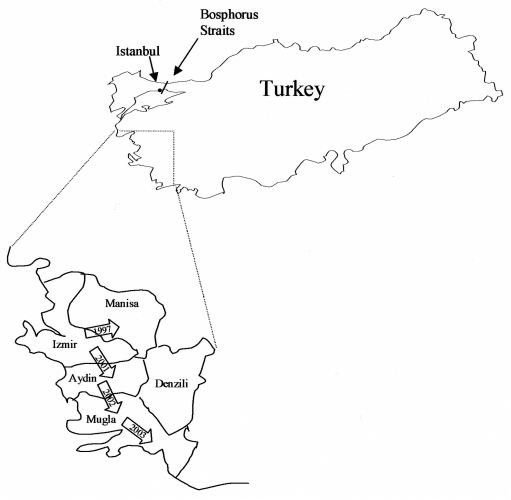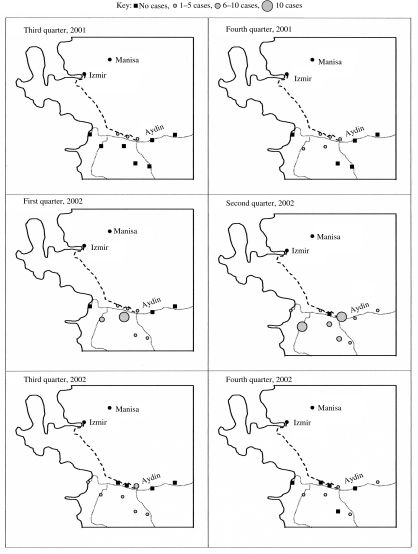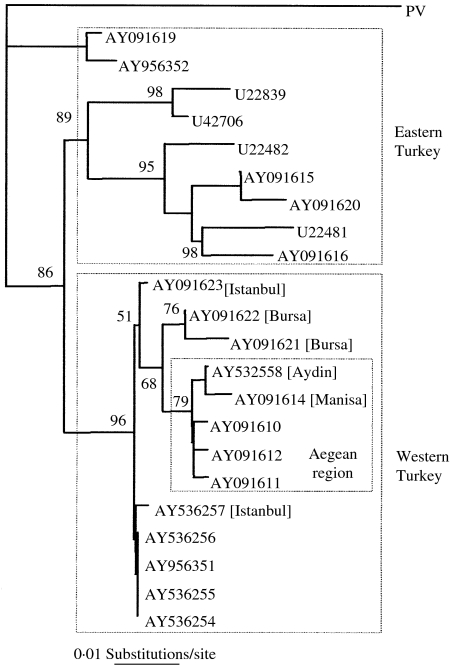SUMMARY
The incidence of rabies has decreased in Turkey during recent years. However, an increasing number of rabies cases have been reported in the Aegean (western) region of Turkey. The virus appears to have maintained a foothold in the urban areas of the province of Izmir with only three cases per year being reported during the mid-1990s. Since 2001, the virus has been recorded in the previously rabies-free provinces of Manisa and Aydin. During this epizootic, cases have been reported in both dogs and foxes, and there has been an unusually high incidence of rabies in domestic livestock, especially cattle. This report describes the development of this epizootic and a preliminary phylogenetic study which suggests that the source of this epizootic was likely to have been the residual cases within Izmir rather than a fresh introduction of rabies from foci to the north (Istanbul) and the Eastern provinces of Turkey.
INTRODUCTION
Turkey is unique in that it is the only European country in which the principal vector for rabies is the domestic dog (Canis familiaris) rather than the fox (Vulpes vulpes). Over 70% of cases are recorded in dogs, followed by cats and ruminants [1, 2]. Occasional cases in wildlife species have been recorded. Surveillance and data collection for rabies is carried out by eight Veterinary Research and Control Institutes that cover the 81 administrative provinces within the country. Over the last 10 years the countrywide trend of reported cases of rabies has been that of gradual decline. This has coincided with the application of a range of control measures that specifically target dog rabies. These include the control of stray dogs and continuous vaccination programmes that have been ongoing since 1946 using the Semple vaccine and the Kelev vaccine strain since 1968 [3]. In more recent times an increasing number of imported tissue-culture vaccines have been used. Further measures include the introduction of local quarantine following the report of a positive case and public education programmes that encourage responsible dog ownership.
Two major foci of rabies have persisted in western Turkey throughout recent campaigns aimed at reducing the prevalence of the disease [4]. The first is the Anatolian region of Istanbul province to the north of the country. The second is the province of Izmir in the western (Aegean) region (see Fig. 1). An associated trend observed in this latter focus of infection has been the increasing number of rabies cases in the fox. The first case was recorded in 1999 in the town of Urla to the west of the city of Izmir. From Table 1 it can be observed that a small but continued increase in the number of fox cases reported is associated with a significant increase in the number of cases in domestic ruminants. These cases (2001) were focused around the phylogenetic investigation of a panel of fox samples from this area and demonstrates that this has been due to spillover from the local dog population [4]. However, this study could not confirm that an independent cycle of infection had been established in this potential vector. The current study details the geographical spread of this outbreak and the host species affected. It also provides evidence that the source is the province of Izmir and not other foci of infection such as that in Istanbul province.
Fig. 1.
Map of Turkey showing the direction of rabies spread in western Turkey between 1997 and 2003.
Table 1.
Rabies cases – Aegean region of Turkey 1999–2003
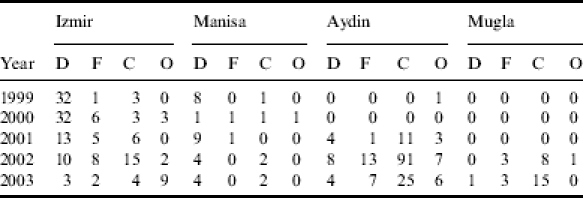
D, dog; F, fox; C, cattle; O, other.
METHODS
Epidemiological data
Epidemiological data was obtained from surveillance information recorded by the Rabies Group at the Etlik Central Veterinary Control and Research Institute, Ankara, and the Bornova Institute, between 1993 and 2003. Supplementary information was obtained from the Rabies Bulletin Europe between 1994 and 2004.
Rabies samples
Brain tissue was obtained during 2003, from a rabid fox from Aydin province from the current epizootic in this province and four samples from rabid jackals (Canis aureus) from Istanbul province. A further sample, also from 2003 was obtained from an infected cow from Hatay province to the east of Turkey. A diagnosis of rabies was made based on a positive result by the fluorescent antibody test [5].
PCR amplification and sequencing
Original brain samples were treated as previously described [4]. Briefly, total RNA was extracted from original brain material using the TRIzol method (Invitrogen Life Technologies, Paisley, Scotland) following the manufacturer’s instructions. RNA was quantified and diluted to 1 μg/μl. Rabies virus genomic RNA was reverse transcribed using the primer JW12 (5′-ATGTAACACC[C/T]CTACAATG-3′) and then amplified with the primers JW12 and JW6(DPL) 5′-CAATTCGCACACATTTTGTG-3′, which produces a 606 base pair (bp) product. Each amplification reaction was separated on a 1% agarose gel and visualized with ethidium bromide staining and UV illumination. Bands were sized by comparison with φx molecular weight markers (Promega, Southampton, UK). Amplification products were sequenced using the BigDyeTM system (Applied Biosystems, Warrington, UK) and analysed by a commercial supplier (Lark Technologies Inc., Takeley, Essex, UK). Sequences were edited using the DNAstar program (DNAstar Inc., Madison, WI, USA).
Phylogenetic analysis
A 453 bp fragment at the 5′-end of the nucleoprotein coding sequence (bases 131–583 of the rabies virus N gene, GenBank Accession no. M13215) was used to compare sequences. Phylogenetic analysis was performed as previously described [6] using the Phylip program (version 3.5) [7]. All sequences generated by this project have been submitted to GenBank.
RESULTS
Description of the rabies epizootic within the Aegean region of Turkey
Rabies control programmes had virtually eliminated the disease from the Aegean region of Turkey with only three cases being recorded in dogs within the city of Izmir in both 1995 and 1996. This changed dramatically in 1997 with an increase in reported cases in both Izmir province and the province of Manisa to the east. In 1999, the first case of a rabid fox was recorded to the west of the city of Izmir. Although the number of cases in dogs began to decline after 2000, the number of fox cases increased as did the number of cases in cattle within Izmir province (Table 1). During the following year the virus was reported in Aydin province to the south (Fig. 1). Prior to 2001, the last recorded case within Aydin province was that of a horse in the town of Aydin itself in 1999. No other cases were reported in the previous year or the following year suggesting that it may have been imported into the province. However, in April 2001, a sporadic case of rabies in a dog was reported in the small town of Germencik. As the year proceeded, further cases were recorded in Germencik and other nearby towns including Aydin and Incirliova. Figure 2 illustrates the steady southerly and easterly spread of the epizootic between the early cases in the third quarter of 2001 and the final quarter of 2002. By the end of 2001, two further towns to the south, Soke and Kocarli, were affected and by the second quarter of 2002, all towns within the province had reported rabies cases. This subsided to only four cases in the fourth quarter of 2003. Throughout the epizootic the majority of cases in Aydin were within domestic livestock, mainly cattle, with much fewer cases reported in either dogs or foxes. During the first and second quarters of 2002, more foxes were recorded than dogs, and between May and July of that year, only cases in foxes were reported.
Fig. 2.
Development of the rabies epizootic in Aydin province between the third quarter of 2001 and the fourth quarter of 2002.
Cases were still being recorded in this area during the early part of 2004 although total numbers are in decline. However, rabid foxes were reported in the province of Mugla, to the south of Aydin, in 2002 after 3 years of freedom from the disease. Unlike the provinces to the north, no cases of rabies within dogs were recorded until the following year, however, the majority of rabies cases were reported in cattle (Table 1).
Phylogenetic investigation
In order to link the rabies epizootic within the Aegean province with the existing foci of infection in Izmir, a phylogenetic analysis using previously described methods [4, 6] was performed on the rabies nucleoprotein sequences derived from samples collected in Izmir, Manisa and Aydin provinces (Table 2). In addition, sequences derived from rabid dogs and jackals from Istanbul province and samples from the eastern provinces of Turkey were included for comparison with those from the Aegean provinces. A 606-bp band was amplified from each brain sample and used to generate nucleoprotein sequences. The phylogenetic analysis compared a 453-bp fragment of the viral nucleoprotein (Fig. 3). This comparison demonstrates the separation of this lineage of rabies virus from rabies samples in eastern Turkey. It also provides further evidence that the population of rabies virus lineage currently circulating in western Turkey is doing so in total isolation to that in the Balkans to the north west and to the epizootic in eastern Turkey. This is based on information from a longer fragment of viral genome than in a previous study [4]. The fox sample from Aydin province shows strong sequence relatedness (<1·5% divergence) to fox samples obtained from the neighbouring provinces of Manisa (AY091610, AY091614) and Izmir (AY091611, AY091612) recorded in 2001. This provides direct evidence that this rabies epizootic has spread south from a foci of infection in Izmir. The phylogeny also suggests divergence of the Aydin/Manisa samples from those from Izmir, although this was not supported by a significant bootstrap value. The four jackal samples from Istanbul province are closely related to a viral sequence (AY956351) obtained from a dog in the same area in 2001, with three of the jackal samples having identical sequences to it. This strongly suggests recent spillover of rabies to jackals from the local dog population. It also demonstrates that the rabies viruses circulating in Istanbul province are distinct from those in the Aegean region of Turkey but share a common ancestor to those virus strains found to the south.
Table 2.
Rabies virus samples used for phylogenetic analysis of Turkish samples
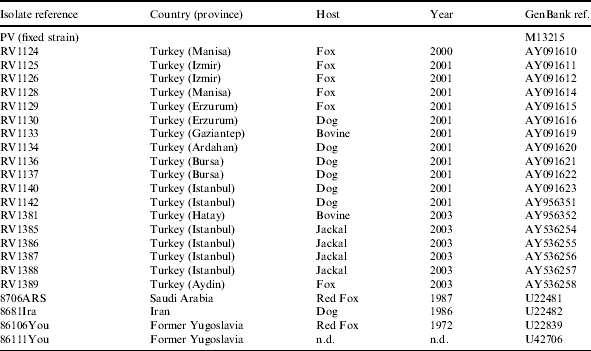
n.d., No data.
Fig. 3.
Phylogenetic relationships between 18 rabies virus samples recorded in western Turkey. Bootstrap values are included and those >70 were considered significant.
DISCUSSION
The increase in rabies cases through the western provinces of Turkey, most of which had been free of the disease, suggests that current control strategies are no longer effective. Both the epidemiological data (Table 1) and the phylogenetic study of a small panel of isolates (Fig. 3) indicate that this has been due to spread from a foci of cases in Izmir province. The phylogenetic analysis suggests that the virus strain circulating in the Aegean provinces has a common ancestor with those present in the province of Bursa to the north and with all viruses present in western Turkey. However, the Aegean group is sufficiently diverse from the Bursa samples to indicate a recent expansion of this virus population. There is no evidence for the introduction of a new variant from other rabies-endemic areas in Turkey such as those in Istanbul province and the sporadic cases reported from the east of the country [4].
The factors that have led to the sudden spread of the disease are unclear. One possible explanation could be the spillover into the fox during the late 1990s. Some of the features of the Aegean epizootic are suggestive of this. Most obviously, a proportion of confirmed cases are samples derived from foxes. In addition, in both Izmir and Aydin provinces a large number of cases were reported in cattle, a sentinel species for rabies in foxes [8]. Interestingly, in Izmir province, as the number of cases in dogs declined the number of cases in foxes and cattle increased (Table 1). The wave-like epizootic spread, both east and south, is similar to the spread of fox rabies through western Europe during the 20th century [9]. This epizootic typically spread between 20 and 60 km/year with a late winter peak of infection [10]. The fox cases throughout western Turkey appear to be spreading at ∼35 km/year. However, this is not conclusive evidence that a separate transmission cycle within a new vector has been established, especially where there is an existing reservoir within dogs. Indeed, future phylogeny studies need to investigate the viral strains infecting both the fox and dog populations within this region. The exception to this may be Mugla province where no cases of rabies in dogs were recorded until 2003.
The possible spread of rabies into the fox population in Turkey shows similarities to historical accounts of rabies spread in Israel following the introduction of vaccination programmes aimed at preventing the domestic dog acting as a reservoir [11]. Once the dog ceased to be a host for rabies, the jackal emerged as the principal host and control measures were directed at this species. Currently, the fox is the principal reservoir species for rabies in Israel. In western Europe rabies has emerged in the raccoon dog (Nyctereutes procyonoides) during the last century [12], probably as a result of a host switch from the red fox. However, the explanation for such host-switching events remains speculative. In Turkey, stray dogs and wild canids are often observed to forage in the same locations, such as waste tips, providing an opportunity for transmission of rabies to a different host species, such as the fox. In provinces such as Aydin and Mugla, cattle are allowed to roam freely throughout the year and are thus accessible to rabid animals and could explain the high incidence of rabies in domestic livestock. Alternatively, improved rabies surveillance of wildlife species could also account for the observed increase of the disease in certain species. The experiences of both Turkey and Israel suggest that control measures aimed at reducing and/or eliminating rabies may have an unexpected consequence in that it appears to increase the chance of host-switching events. It seems unlikely that this is due to a property of the virus. The reduction of stray dogs within urban areas may have created a new ecological niche that has been filled by foxes which are highly adaptable and thrive in such environments. This may have increased the probability of an infected dog coming into contact with a susceptible fox. In western Europe, no such host-switching event was recorded from the fox which led to lasting epizootics, possibly through the absence of suitable host species. A possible exception to this has been the development of rabies in the raccoon dog. More detailed phylogenetic investigations of larger panels of viral isolates from this region of Turkey are needed to provide further information on the reservoir species responsible for these epizootics, especially in identifying the source of ruminant cases of rabies and thus assisting with control strategies. Whilst the numbers of actual cases within both the dog and fox populations remains low, there is hope that control strategies will be effective.
ACKNOWLEDGEMENTS
This work was supported by a grant (SEO417) from the Department for Environment, Food and Rural Affairs, UK. The authors acknowledge the Turkish government for providing a travel bursary which has assisted in this study, and Miss Verity Crossen for assistance in data preparation.
DECLARATION OF INTEREST
Dr Vos is employed by a company that manufactures oral rabies vaccine baits.
REFERENCES
- 1.Aylan O, Yoruk I, Un H. Rabies in Turkey. J Etlik Vet Microbiol. 1998;9:3–8. [Google Scholar]
- 2.Akkoca N, Economidies P, Maksound G, Mesyom M., King AA, Fooks AR, Aubert M, Wandeler AI, Historical perspectives of rabies in Europe and the Mediterranean basin. World Organisation for Animal Health (OIE); Paris: 2004. Rabies in Turkey, Cyprus, Syria and Lebanon; pp. 157–169. [Google Scholar]
- 3.Kalmar E, Tadmor A. Immunization of cattle against rabies with the Kelev strain vaccine. Res Vet Sci. 1968;9:424–428. [PubMed] [Google Scholar]
- 4.Johnson N, Black C, Smith J, Un H, McElhinney LM, Aylan O, Fooks AR. Rabies emergence among foxes in Turkey. J Wildl Dis. 2003;39:262–270. doi: 10.7589/0090-3558-39.2.262. [DOI] [PubMed] [Google Scholar]
- 5.Dean DJ, Abelseth MK., Kaplan MM, Koprowski H. Laboratory techniques in rabies. 3rd edn. Geneva: World Health Organisation; 1973. The fluorescent antibody test; pp. 73–84. [PubMed] [Google Scholar]
- 6.Johnson N, McElhinney LM, Smith J, Lowings P, Fooks AR. Phylogenetic comparison of the genus Lyssavirus using distal coding sequences of the glycoprotein and nucleoprotein genes. Archiv Virol. 2002;147:1222–2123. doi: 10.1007/s00705-002-0877-4. [DOI] [PubMed] [Google Scholar]
- 7.Felsenstein J. PHYLIP – phylogeny inference package version 3·2. Cladistics. 1989;5:164–166. [Google Scholar]
- 8.Lloyd HG. Wildlife rabies in Europe and the British situation. Trans R Soc Trop Med Hyg. 1976;70:179–187. doi: 10.1016/0035-9203(76)90036-5. [DOI] [PubMed] [Google Scholar]
- 9.Steck F, Wandeler A. The epidemiology of fox rabies in Europe. Epidemiol Rev. 1980;2:71–96. doi: 10.1093/oxfordjournals.epirev.a036227. [DOI] [PubMed] [Google Scholar]
- 10.Toma B, Andral L. Epidemiology of fox rabies. Adv Virus Res. 1977;21:1–36. doi: 10.1016/s0065-3527(08)60760-5. [DOI] [PubMed] [Google Scholar]
- 11.David D, Yakobson B, Smith JS, Stram Y. Molecular epidemiology of rabies virus isolates from Israel and other middle-and near-eastern countries. J Clin Microbiol. 2000;38:755–762. doi: 10.1128/jcm.38.2.755-762.2000. [DOI] [PMC free article] [PubMed] [Google Scholar]
- 12.Bourhy H, Kissi B, Audry L et al. Ecology and evolution of rabies virus in Europe. J Gen Virol. 1999;80:2545–2557. doi: 10.1099/0022-1317-80-10-2545. [DOI] [PubMed] [Google Scholar]



